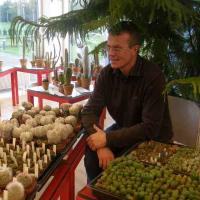
Could stem agglomeration be a problem when writing texts in Esperanto?
de robinast, 17 decembrie 2008
Contribuții/Mesaje: 15
Limbă: English
robinast (Arată profil) 17 decembrie 2008, 21:59:33
Ĉiuj miaj ĉevaloj estas en la ĉevalejo: ĉevalinoj, virĉevaloj, virĉevalidoj kaj ĉevalidinoj - eĉ plej kompatindaj ĉevalaĉoj.
All my horses are in the stables: broodmares, stallions, foals and fillies - even the poorest screws.
(In Estonian) Kõik mu hobused on tallis: märad, täkud, täkkvarsad ja märavarsad - isegi armetuimad kronud.
Such an agglomeration of identical stems (7 in this "ĉeval"-sentence in Esperanto) is far from being desired, though. This example, of course, is a poor one and not realistic, anyway, I hope it illustrates what I have in my mind.
A more realistic situation would be writing a dialog á la 'direct speech + accompanying sentence "s/he said" '. Using synonyms of the "to say" with different stems and varying shades of meanings, one can easily write a lively and interesting dialog without repeating stems for a long time.
Have I got it right that Esperanto has a far lesser amount of synonymous stems than natural languages? If yes, does this mean that one could run into a problem with this stem agglomeration?
Harri.
Rogir (Arată profil) 18 decembrie 2008, 00:17:03
RiotNrrd (Arată profil) 18 decembrie 2008, 01:00:19
But, in general, Esperanto does have far fewer such roots than the natural languages. It is one of the prices of simplicity.
danielcg (Arată profil) 18 decembrie 2008, 02:18:47
First let's translate your example into the language of Cervantes and Borges:
"Todos mis caballos están en la caballeriza: yeguas, caballos, potrillos y potrancas, y hasta los más lamentables matungos".
("Matungo" is an Argentine localism, I don't know how to say this is classic Spanish.)
I have read many books in Esperanto, both original and translated, and I can witness that skilled writers manage to give beauty to their writings. Though Esperanto does not have so many synonims as other languages, it has more flexibility in the word order and also the possibility of building joint words, and a good writer will make extensive use of these features to compensate for having fewer synonims.
I don't think I'm such a writer, but anyway I would rephrase your example this way:
"Ĉiuj miaj ĉevaloj estas en sia bestejo: geplenkreskuloj, ambaŭseksaj idoj - eĉ plej kompatindaj ĉevalaĉoj."
Having introduced the phrase with "ĉiuj miaj ĉevaloj", it is understood that all the animals mentioned belong to that species and that the "bestejo" is a "ĉevalejo", because it is "sia bestejo", i.e. "la bestejo de ĉevaloj".
Regards,
Daniel
robinast:I know the Esperanto not well yet, of course, as I only recently started to learn it. But as much as I have understood, beside the very regular grammar, one of the advantages of it is also it's power of forming words from stems combining them with different affixes. So, one would need less stems to memorize to be able to construct f.e. such a sentence (if to compare with the English and Estonian):
Ĉiuj miaj ĉevaloj estas en la ĉevalejo: ĉevalinoj, virĉevaloj, virĉevalidoj kaj ĉevalidinoj - eĉ plej kompatindaj ĉevalaĉoj.
All my horses are in the stables: broodmares, stallions, foals and fillies - even the poorest screws.
(In Estonian) Kõik mu hobused on tallis: märad, täkud, täkkvarsad ja märavarsad - isegi armetuimad kronud.
Such an agglomeration of identical stems (7 in this "ĉeval"-sentence in Esperanto) is far from being desired, though. This example, of course, is a poor one and not realistic, anyway, I hope it illustrates what I have in my mind.
A more realistic situation would be writing a dialog á la 'direct speech + accompanying sentence "s/he said" '. Using synonyms of the "to say" with different stems and varying shades of meanings, one can easily write a lively and interesting dialog without repeating stems for a long time.
Have I got it right that Esperanto has a far lesser amount of synonymous stems than natural languages? If yes, does this mean that one could run into a problem with this stem agglomeration?
Harri.
danielcg (Arată profil) 18 decembrie 2008, 02:22:08
Daniel
ceigered (Arată profil) 18 decembrie 2008, 02:49:40
I agree with what danielcg said about horses already being introduced as the animal being talked about. However I personally would have defined stable as 'cxevalejo' and not 'bestejo' as it could be understood that other animals are residents of that bestejo.
I agree that using the same stems over and over could cause problems, this is probably because Esperanto's main purpose is to help international communication, as a result other compromises are made.
erinja (Arată profil) 18 decembrie 2008, 03:55:21
ceigered (Arată profil) 18 decembrie 2008, 04:09:50
erinja:I have occasionally had problems with using the same stem over and over, but not very much more than English. English certainly has its share of "In the discussion, we discussed..." etc. I ran across it even today, writing something at work, I was having a hard time coming up with a good alternate way to say something, even though English has many synonyms.I always go for the 'dumb down the next word' approach, e.g. 'In the discussion, we talked about'.
Isn't it funny. English is meant to have a nearly '1 French word for 1 Anglic word' system but often we give synonyms slightly different connotations for some reason, like 'grand' and 'big' essentially mean the same but somehow they don't.
robinast (Arată profil) 18 decembrie 2008, 06:22:47
danielcg: Though Esperanto does not have so many synonims as other languages, it has more flexibility in the word order and also the possibility of building joint words,I've got used to it already - in that sense, the Estonian and Esperanto are very similar to each other.

danielcg:So, the suffix "-ul-" can be used also in case of animals?
"Ĉiuj miaj ĉevaloj estas en sia bestejo: geplenkreskuloj..."
RiotNrrd: Some people actually feel that Esperanto currently has too MANY synonymous rootsYes? Sounds a bit odd for me... More synonyms give more flexibility however. I can easily name more than a dozen of synonyms for "to say" in Estonian in a few minutes - but I do not feel at all that this would be too much. Of course, mostly only a couple of them are constantly in use in a daily communication, anyway, it does not mean that there is no need for more.
Amike,
Harri.
Matthieu (Arată profil) 18 decembrie 2008, 17:05:13
robinast:So, the suffix "-ul-" can be used also in case of animals?It is not really common, but it is possible.
I think it is mainly used to name animal orders; for example rodents are called ronĝuloj.





